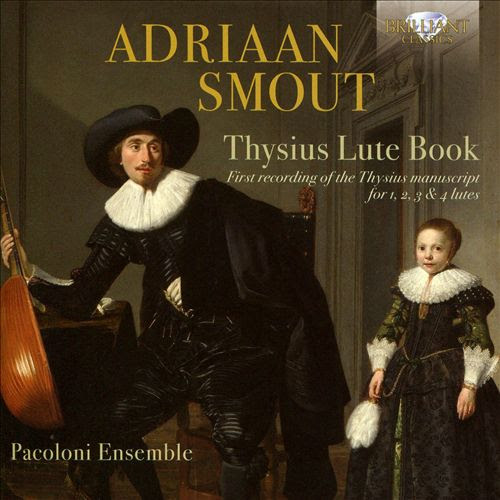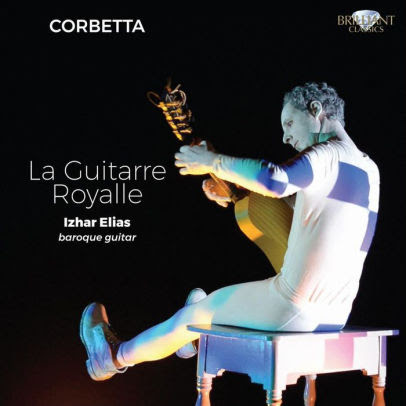Program: #19-15 Air Date: Apr 01, 2019
To listen to this show, you must first LOG IN. If you have already logged in, but you are still seeing this message, please SUBSCRIBE or UPGRADE your subscriber level today.
The Thysuis lute book, keyboard music from Renaissance Poland, and guitar works of Francesco Corbetta.
I. Adriaan Joriszoon Smout (1578/9-1646): Thysius Lute Book. (Pacoloni Ensemble). Brilliant Classics CD 95821.

Adriaan Smout (1578-1646) was a philosopher, teacher and preacher who collected and transcribed the music that came his way from across Europe. He lived, worked and died in Rotterdam, a city that has always been well-placed to capitalize on international commercial and cultural links to support a distinguished history of music publishing. The contents of Smout's collection, which found its way into the Thysius library in Leiden, embraces musical forms amongst the most popular of the late-Renaissance and early-Baroque periods: songs, branles, galliards and allemandes. There is also a bergamasque (a shepherd's song) which, in its extreme simplicity, has been taken by the Italian musicians of the Pacoloni Ensemble as an opportunity for improvisation and variation. The original authors have nearly all been lost in the mists of time, except for Smout's transcription of ´Can she excuse´, a song by John Dowland. Up to four lutes are used, and several tracks are enhanced by percussion which would have lent color and rhythmic strength to this music played in its own time: the manuscript as a whole has been freshly edited, and taken as the basis for richly textured and melodically elaborated performances which do not confine themselves to the literal indications of the tablature. Led by their founder-director Roberto Cascio, the musicians of the Pacoloni Ensemble have been performing together for two decades. They are all members of other early-music ensembles who come together to explore the treasure-trove of little-known repertoire written during the golden age of the lute.
Adriaan Smout (1578-1646) was a philosopher, teacher and preacher who collected and transcribed the music that came his way from across Europe. He lived, worked and died in Rotterdam, a city that has always been well-placed to capitalise on international commercial and cultural links to support a distinguished history of music publishing.
The contents of Smout’s collection, which found its way into the Thysius library in Leiden, embraces musical forms amongst the most popular of the late-Renaissance and early-Baroque periods: songs, branles, galliards and allemandes. There is also a bergamasque (a shepherd’s song) which, in its extreme simplicity, has been taken by the Italian musicians of the Pacoloni Ensemble as an opportunity for improvisation and variation. The original authors have nearly all been lost in the mists of time, except for Smout’s transcription of ´Can she excuse´, a song by John Dowland.
Up to four lutes are used, and several tracks are enhanced by percussion which would have lent colour and rhythmic strength to this music played in its own time: the manuscript as a whole has been freshly edited, and taken as the basis for richly textured and melodically elaborated performances which do not confine themselves to the literal indications of the tablature.
Led by their founder-director Roberto Cascio, the musicians of the Pacoloni Ensemble have been performing together for two decades. They are all members of other early-music ensembles who come together to explore the treasure-trove of little-known repertoire written during the golden age of the lute.
The Thysius Lute Book is one of the most important and substantial collections of lute music from the 16th and 17th century. The collector was Adriaan Joriszoon Smout, Dutch philosopher, teacher and preacher, who brought together a staggering amount of 900 compositions in 522 folios. The music in the collection is a reflection of the musical taste of the day, which was a melting pot of styles from all over Europe, and gives us a glimpse of what domestic music making was in the Golden Age.
The works are for a variety of instruments, and the present recording offers works for 1, 2, 3 and even 4 lutes. The forms are mainly dances, composed on a basso ostinato, as well as instrumental versions of popular songs.
The Pacoloni Ensemble is an Italian group specialized in the research and performance of music for the lute, whether solo or in ensemble. The excellent liner notes are offered in both English and Italian.
-
Thysius Lute Book: I. Si vous estes belle/Reprinse
-
Thysius Lute Book: II. Passomezo haubois/Gailliarde haubois
-
Thysius Lute Book: III. Jan Dirrixz
-
Thysius Lute Book: IV. Ick clam den boom al op
-
Thysius Lute Book: V. Onse Vader
-
Thysius Lute Book: VI. Wie sal mijn troetelen
-
Thysius Lute Book: VII. Gaet hem toe
-
Thysius Lute Book: VIII. Wilhelmus van Nassowen
-
Thysius Lute Book: IX. Can shee excuse
-
Thysius Lute Book: X. Brande d’Angleterre
-
Thysius Lute Book: XI. Rogier
-
Thysius Lute Book: XII. Passomezo del Zorzi
-
Thysius Lute Book: XIII. Galliarda la gamba
-
Thysius Lute Book: XIV. Passomezo la Romanesqua/Gallarde la romanesqua
-
Thysius Lute Book: XV. Galliarda la caracossa
-
Thysius Lute Book: XVI. Passomezo d’Italie/Gailliarde d’Italie
-
Thysius Lute Book: XVII. Gailliarda chi passa
-
Thysius Lute Book: XVIII. Bargamasco
-
Thysius Lute Book: XIX. Almande mon varle
-
Thysius Lute Book: XX. Gallarde Fransoyse
-
Thysius Lute Book: XXI. Gallarde de royne d’escosse
-
Thysius Lute Book: XXII. Gallarde belle qui me vas martirant
-
Thysius Lute Book: XXIII. Brande battaille
II. Johannes de Lublin tablature (1540). (Corina Marti, Renaissance harpsichord). Brilliant Classics CD 95556.

The richness of the repertory is impressive, both in terms of musical genres and composers represented as well as the instrumental techniques employed. We find works of Polish, German, Italian and French origin, varying from Polish folk dances to tablatures of vocal works by Josquin, Brumel, de Sermisy, Walter and others.
Corina Marti, plays an historical Renaissance harpsichord. She is a specialist in Early Music and a professor at the prestigious Schola Cantorum Basiliensis in Basel.
This unique recording was made possible with the support of the Adam Mickiewicz Institute in Poland.
Booklet essay by Pawel Gancarczyk, in a faultless English translation, is both wide-ranging and detailed, and altogether extremely informative. This recording, sponsored by the Adam Mickiewicz Institute named after the eponymous 19th-century Polish poet, is an enterprising and beautifully executed project. It can be strongly recommended to fans of keyboard and other early music.
2. Surrexit Dominus valete luctus (70v)
3. [Passamezzo antico] / Proporcia Jeszcze Marczynye (188v/189r)
4. [Deus qui sedes super thronum] (after Johann Walter) (204r)
5. Zaklolam szÿa tharnem (215r)
II.
6. [Preambulum] in e (19v)
7. Absolon [= Rex autem David] (after Antonio de Ribera) (253v)
8. Corea (212r)
9. Poznanie (112r)
10. Francigenum [= Le content est riche] (after Claudin de Sermisy) (28r)
11. [D’ung desplaisir] (after Jacotin Le Bel) (28v)
12. [Corea] (103v)
13. [Corea] (111v)
14. Preambulum in a per h (91v)
15. Date siceram merentibus [= Je ne puis me tenir] (N[icolaus] C[racoviensis], after Jhan Gero) (200v)
III.
16. Preambulum super d (19r)
17. Bona [?corea] (218v)
18. Veschol [= Dont vient cela] (after Claudin de Sermisy) (90v)
19. Ad novem saltus (220r)
20. Haÿduczkÿ (220v)
21. Vita in lingo moritur (after Ludwig Senfl) (171r)
22. Pressa (95v/165v)
23. Preambulum in d (N[icolaus] C[racoviensis]) (160v)
24. Schephczyk ÿdzÿe po ulÿczÿ schÿdelka noschacz (222r)
25. [Corea] (222v)
IV.
26. Preambulum super f (98v)
27. Ave Jerarchia (N[icolaus] C[racoviensis]) (108v)
28. Colenda Severini (?Severinus Konij) (146v)
29. Anglicum (200r)
30. Preambulum in d (233r)
31. Dulce memorie [= Doulce memoire] (after Pierre Sandrin) (197v)
32. Plus mille regres [= Plus nulz regretz] (after Josquin des Prez) (254v)
33. Aliud preambulum (242)
34. Rex (132r)
V.
35. Tribulatio [et angustia] (?after Josquin des Prez) (235v)
36. [Corea] italica (221r)
37. Conradus (37r)
38. Preambulum in c (18v)
39. Sicut lilium inter spinas (after Antoine Brumel) (97v)
III. La Guitarre Royalle (Izhar Elias, baroque guitar). Brilliant Classics CD 95587.

On this album Elias has made his own selection from two of Corbetta’s published volumes which were written for King Charles II (1671) and King Louis XIV (1674) respectively. According to him, Corbetta’s music is rooted in the popular songs and dances of his day, making him more like a modern pop songwriter. Using the genres of chaconne and passacaglia, several of which are included here, he transformed the guitar into a polyphonic instrument and a genuinely soloistic one compared to its previous, humble role as an accompaniment to song and strings. There are also two substantial dance suites, in A minor and G minor. The high range, frequent resolution of dissonance, virtuosic techniques, and coloristic effects, such as overlapping tones of campanelas or flashy repicco strumming, converged in his guitar music to make it the most brilliant if challenging of the era.
Composer Info
Adriaan Joriszoon Smout (1578/9-1646), Johann Walter, Antonio de Ribera, Claudin de Sermisy, Jacotin Le Bel, Jhan Gero, Ludwig Senfl , Pierre Sandrin, Josquin des Prez, Antoine Brumel, Francesco Corbetta
CD Info
Brilliant Classics CD 95821, Brilliant Classics CD 95556, Brilliant Classics CD 95587